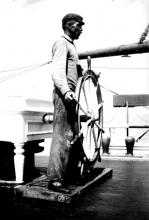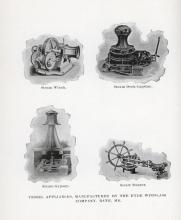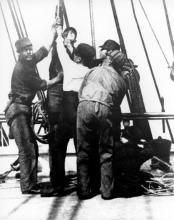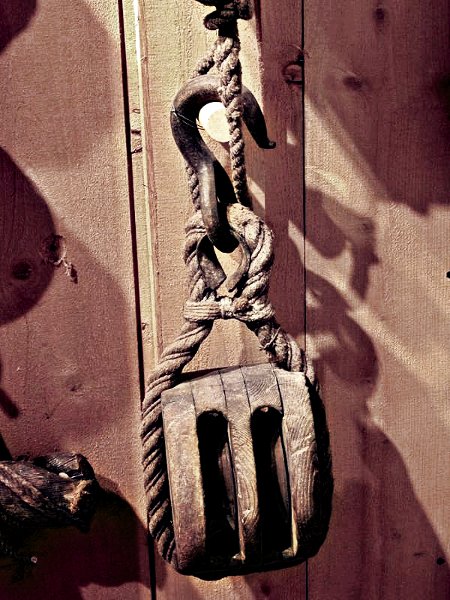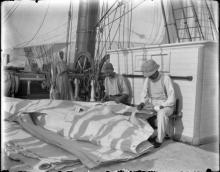Work at Sea
Watches
To sail the ship day and night, the crew was broken into two watches: the port or larboard watchWatch
A portion of the ship's crew on duty at a given time to run the vessel. and the starboard watch. The first mate was in charge of the larboardLarboard port
Larboard is the old term for the left side of a ship when facing forward, now called port. The change to port was made official in 1844. The first mate's watch on a sailing ship was called the port or larboard watch. watch, the second in charge of the starboardStarboard
The right-hand side of a vessel as seen from aft.
Read More watch. Each watch lasted four hours. They began at midnight, 4:00am, 8:00am, noon, 4:00pm, and 8:00pm. Even though watches continued through the day, all hands worked from noon to 4:00 pm maintaining the ship.
Before clocks, ship’s time was kept with a half hour sand glassSand glass sandglass
A means of measuring time on board ship before the development of reliable clocks for ships. Two vacuum globes connected by a narrow neck, allowing sand to run from the top globe into the bottom one in a given period of time.
Read More and a bell rung at the turning of the glass. A ship's clockShip's clock
Clock aboard a ship that typically rings the time in bells, with eight bells every 4 hours, and one bell at a half hour after eight bells, marking the watches. Traditionally the ship's clock was reset to noon based on daily sun observations. did the same. It rang eight bells at the change of the watch. It then rang one bell for each half hour after that, but in pairs. For example, at 2:30, five bells would sound: ding-ding, ding-ding, ding.
On American ships it was common to alternate watches daily, breaking one four hour watch period in half. These dog watchesDog watch
Two half watches of two hours each into which the period from 4 pm to 8 pm is divided. The purpose of dividing this watch into two parts is to produce an uneven number of watches in 24 hours, 7 instead of 6.
Read More ran from 4:00 to 6:00 pm and from 6:00 to 8:00 pm. The 4:00 watch had light duty—just steering and handling ship as needed. Supper was served to the off watch towards 6:00 and then at 6:00 the off going watch ate, with the new watch taking over the ship.
Ship Operations
Hauling in, or weighingWeigh
To raise or lift the anchor in readiness to sail., a 4,000 pound ship’s anchor required hard work and mechanical advantageMechanical advantage
Extra power or strength obtained by using a simple machine.. In the early to mid-nineteenth century, anchors were weighedWeigh
To raise or lift the anchor in readiness to sail. with a windlassWindlass
A machine for lifting the anchor. Similar to the capstan but on a horizontal shaft., a large, horizontal drum with ratchetsRatchet
A ratchet refers to a toothed bar with which a pivoted bar can engage. It is used to prevent or aid motion. A ratchet windlass is a simple form of hand-worked windlass consisting of a horizontal drum pierced to hold handspikes. on it. The drum turned as the arms of the windlass went up and down. A simple vertical-axis capstanCapstan
A machine used on board ship to provide mechanical power to raise the anchor, hoist yards, or lift heavy weights. The capstan consists of a cast-steel barrel mounted on a vertical spindle and smallest in diameter around the middle, to allow for the rope to wind up or down as the capstan is turned. At the top of the barrel, capstan bars are fitted into slots (pigeon holes) to allow sailors to turn the capstan. was also used, and by the late nineteenth century it had developed into an iron two-speed gearedGear
The ropes, blocks, and tackles of a particular sail or spar. In more general terms, gear refers to any arrangement of machinery.
Read More machine that made bringing in the anchor much easier. Sailors got leverage by pushing its long capstan barsCapstan bars
The removable bars at the top of the capstan. Their length varies from 5 to 6.5 feet. Also called handspikes. or handspikesHandspikes
Capstan bars..
Watch this short demonstration of working the capstan at Penobscot Marine Museum.
If at anchor at the beginning of a voyage, the ship’s sails would be setSet sail
To begin a voyage. This term is used for mechanically-powered vessels as well as for sailing vessels. To set the sails on a vessel is to raise, open, and extend them to the wind., ready to catch the wind, before the anchor was completely raised. On a square-riggedSquare-rigged
The arrangement of sails in a vessel where the main driving sails are laced to yards lying square to the mast. It is the oldest type of known rig. Such a vessel is called a square rigger. Down EasterDown Easter downeaster; down-easter
Merchant sailing ship developed in Maine in the 19th century and designed for maximum carrying capacity with minimal crew size.
Read more, there were usually fifteen to eighteen square sailsSquare sail
A trapezoidal-shaped sail laced to yards on square-rigged ships.. Some were set by climbing into the riggingRig
The general term describing the characteristics of masts and sails that determine the type of sailing vessel.
Read More, untying gasket linesGasket gasket
A rope, plaited cord, or strip of canvas used to secure a furled sail to a yard or boom. that held the furledFurl
To take in the sails of a vessel and secure them with gaskets. In the case of square-rigged ships, to haul in on the clew-lines and buntlines and roll sails up to the yards. In the case of fore-and-aft rigs, to lower and secure sails to the boom or stays. sails to the yardsYard
The large wooden or metal spar crossing the masts horizontally or diagonally, from which a sail is set., then letting buntlinesBuntline
One of the lines hauling the foot of a sail above and forward of the yard for convenience in furling. go to allow the sail to drop.
Other sails required the yard to be pulled or hauled part way up the mast with the halyardHalyard halliard
A rope used for hoisting or lowering yards, spars, or sails on their respective masts or stays. From "haul yard.", the line used to “haul the yard” up the mast. The fore-and-aft sailsFore-and-aft sails
Sails that attach to the mast or stays by their forward edge. They are set on stays, gaffs, booms, etc., and are generally triangular or trapezoidal in shape., including jibsJib
A triangular sail set by sailing vessels on the stays of the foremast. The largest square-rigged sailing vessels of the late 19th and early 20th centuries carried as many as six jibs., staysailsStaysail
A triangular fore-and-aft sail which is set by being hanked (fastened with small rings or hoops) to a stay (the part of the standing rigging which supports the mast) Staysails are set in both square-rigged and fore-and-aft rigged vessels., and spankerSpanker
An additional sail hoisted on the mizzen mast of sailing ships to take advantage of a following wind., were also raised with halyards. Our movie clip demonstrates furling the sails and tying them up to the yards with gasket lines.
Lines to the sails’s corners and yards controlled the sails. SheetsSheet sheets
The controlling line attached to a sail. pulled down the lower corners of the sails; bracesBrace
Rope that controls the horizontal motion of the yards, or (verb) to swing or turn around the yards of a ship by means of the braces. set the proper angle of the yard and the sail to the wind.
Sailors steered the ship, taking their orders from the mates. On larger ships, there were sometimes two wheels, so that more men could steer in bad weather. In a bad storm, the ship’s planking might open, letting seawater into the hull. Some ships were old and leaked even in calm weather. Seamen had to pump water out of the hold. This could be a terrifying job: sailors might be pumping for their lives, trying to keep up with the leaks.
Ship Maintenance
Ship maintenance was part of every seaman’s life. Water created rust and rot, and the ship’s constant motion chafedChafing gear
Constant motion on ship made rigging and sails wear out when they rubbed or chafed against each other.
Read More rope and canvas. The crew washed and cleaned the decks; and sanded and painted wood where old paint was beginning to chip. They made sure all shacklesShackle shackles
A bow-shaped or U-shaped steel or iron fitting with a pin across the throat end, used as a connection between lengths of chain or to attach other fittings. Shackles used in the rigging have a threaded pin, and those used for joining lengths of anchor chain have a smooth heavy pin. holding blocksBlock
A pulley, consisting of a frame or shell which supports a sheave or roller, over which ropes are run. There are many kinds of blocks. Blocks with ropes run through them form a tackle. and lines were secure and checked rope splicesSplice
The method of joining tow ropes or wires together by unlaying the strands at the two ends and tucking or relaying them according to the nature of the splice required.. They had to maintain the capstan or windlass and the pumps; renew chafing gearChafing gear
Constant motion on ship made rigging and sails wear out when they rubbed or chafed against each other.
Read More; repair and tar the standing riggingStanding rigging
The lines that hold up the mast. They are wormed, parceled, and served for water-proofing.; varnish woodwork; and repair sails. Major storm damage was repaired at sea if possible.

